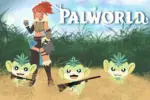Throughout the Pikmin games, players meet and explore with seven types of Pikmin of different colors and sizes. Despite the fact that there is a trilogy of Pikmin games, a Nintendo Switch remaster of Pikmin 3 and a 3DS spin-off game, we still don’t know that much about them. What exactly are Pikmins and how did they come to be? Well, much of this may be explained by analyzing the Pikmin parasite and how it may contribute to the evolution of the species.
Let’s start by going over the Pikmin and what we do know about them. We know that Pikmin are strange plant-like creatures that lack many of the instincts necessary for survival, but also adapt to handle a variety of circumstances. Captain Olimar states that Pikmin resemble PikPik carrots, which are common vegetables on his home planet of Hocotate.
We also know from Olimar’s entry in the Piklopedia that Pikmin have a parasitic strain, called Bulbmin, that have adapted to infect the Pikmin’s most common predator: the Bulborb. Led by a single adult, these Bulbmin travel in groups across many different cavern systems. Players can often encounter Bulbmin in caves throughout Pikmin 2, and they will join you if a captain whistles at them once the adult is killed. Pikmin appear to have an instinctive desire to be led, which may explain their lack of survival skills.
If Pikmin do have parasitic strains, then it begs the question: What if Pikmin actually did originate from PikPik carrots? That would mean that their sentience comes from a different organism, a parasite perhaps, and a highly evolved parasite at that.
More evidence to support the theory that the Pikmin parasite could give life to inanimate objects such as PikPik carrots can be found in the form of rock Pikmin. Rock Pikmin appear to be small pieces of rock that look similar to coal, yet also have the plant stems, eyes and arm and leg-like limbs of Pikmin.
The fact that Pikmin have limbs that imitate arms and legs that allow them to climb, carry objects, move and jump may create skepticism for this theory, but this can likely be explained by the physical makeup of the Pikmin parasite. Well, the Piklopedia entry for the Bulbmin states that Pikmin parasites have “rootlike limbs” that burrow into the nervous system of its host, “usually a Bulborb.” Theoretically, these rootlike limbs are responsible for Pikmin having these arm-like and leg-like appendages. The word “usually” also appears to imply that the Pikmin parasite has infected other hosts as well that the players haven’t been made aware of.
If the Pikmin parasites have infected other unknown hosts, it’s possible that they have also infected flying insects, most likely snitchbugs because winged Pikmin have beady eyes similar to snitchbugs. If so, the snitchbugs may have given a strand of Pikmin parasites the genetic materials needed to imitate wings, leading to the creation of the winged Pikmin.
It appears likely that the first Pikmin was a red one, since the PikPik carrots are red as well. The parasite the Pikmin were created from appears to have many different strains that provide immunity to one element or threat that plagues its species. Specifically, red Pikmin are made from a parasitic strand that developed an immunity to fire, yellow Pikmin were created from a parasite that could conduct electricity, blue Pikmin were born from a parasitic strain that could survive in water and white Pikmin were created from a strain that could survive with poison.
The parasites that create Pikmin appear to be fungal. According to Brittanica, fungal parasites can enter plants through the roots or the leaves. Some fungal parasites have microscopic spores that spread in a sort of powder. This is evidenced by the Onions that house and create Pikmin, which appear to excrete a similiar powder. Furthermore, strange flowers called candypop buds also expel powder to transform Pikmin into different colors.
Unfortunately, the Pikmin parasite and its reproductive capabilities are still imperfect. For one thing, pureblood Pikmin can only be immune to one element at a time. For instance, if a red Pikmin is turned into a blue one, they trade their fire immunity for the ability to survive in water, and so on and so forth.
Curiously however, Bulbmin are immune to fire, water, poison and electricity. Some of this immunity could be attributed to the Bulborb’s biology. After all, the Fiery Bulblax excretes a waxy substance that not only protects it from fire, but produces it. Also, water dumplings are amphibious, meaning they can survive both on land and underwater. Olimar calls the water dumpling a cousin of the Bulborb in a Piklopedia entry. Because all three of these species are members of the grub-dog family, it’s possible that the Bulbmin may have immunity to fire and water from their biology. Bulbmin’s immunity to poison may be attributed to the fungal parasites that infected it since white Pikmin are immune to poison, and there are no known species of Bulborb immune to poison.
Furthermore, while the Onions are capable of creating new Pikmin by breaking down pellets and corpses, they only break them down to create Pikmin. They don’t infect other species with the parasitic spores inside the Onion, not even creatures that may still be alive when being carried to the Onion like the Spotty Bulbear or the infamous Gattling Groink.
Frighteningly however (spoiler warning), the bad ending of the first Pikmin game shows that the Onions are indeed capable of infecting other organisms. After Olimar crashes in an attempt to escape the planet and presumably suffocates from the oxygen, the Pikmin carry his body back to the Onion. It is then absorbed and used to create a Pikmin which assumes Olimar’s form, complete with a swaying leaf growing out of its head.
It can be easy to assume that the Pikmin parasite does not infect fallen prey because it’s not advanced enough, but the possibility of Olimar becoming a Pikmin appears to suggest that the Pikmin decide not to use this ability in front of Olimar or other captains.
The Pikmin parasite appears to evolve by absorbing genetic materials from their hosts. This may sound like a stretch, but it’s not out of the realm of possibility that Pikmin parasites may have even infected humans. There are various signs of human civilization on the planet such as phones, jewelry and even footprints. Human possession by Pikmin parasites may be responsible for the creation of purple Pikmin. Purple Pikmin appear to have strands of hair on their heads. They are also heavier and stronger than other types of Pikmin. Yellow Pikmin even have ears like humans. Pikmin may have learned how to climb and carry objects from humans, since a Pikmin parasite can execute many if not all of the bodily functions of its host according to the Piklopedia.
Pikmin appear to achieve life through parasites and it spreads to other living and nonliving things as well. A lot can be learned about them through observation, research and experience, although not all of what the Pikmin parasites can do are rooted in real life. There are no known parasites that bring carrots to life, but in the world of Pikmin, it works very well in its own strange way. In time, there may be no limit to what could join the ranks of the Pikmin, and it will be interesting to see how they continue to develop in future games.
















